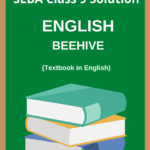Class 9 English Chapter 12 A Visit To Kaziranga And Sibsagar, NCERT/SCERT Class 9 English Beehive Question Answer to each chapter is provided in the list of SEBA ইংৰাজী Class 9 Question Answer so that you can easily browse through different chapters and select needs one. Class 9 English Beehive Prose Chapter 12 A Visit To Kaziranga And Sibsagar Question Answer can be of great value to excel in the examination.
Class 9 English Chapter 12 A Visit To Kaziranga And Sibsagar
SEBA Class 9 English Chapter 12 A Visit To Kaziranga And Sibsagar Notes covers all the exercise questions in Assam Board SEBA Textbooks. The SEBA Class 9 English Beehive Chapter 12 A Visit To Kaziranga And Sibsagar provided here ensures a smooth and easy understanding of all the concepts. Understand the concepts behind every chapter and score well in the board exams.
A Visit To Kaziranga And Sibsagar
Chapter – 12
BEEHIVE (PROSE)
TEXTUAL QUESTIONS AND ANSWERS
Thinking about the text:
I. Choose the right answer:
(i) When something is conserved it is preserved/destroyed.
Ans. When something is conserved, it is preserved.
(ii) Herbivorous animals eat flesh/grass.
Ans. Herbivorous animals eat grass.
(iii) When you excavate, you dig out/ cover up something.
Ans. When you excavate, you dig out something.
(iv) When you visit a historical site, you see new/old monuments.
Ans. When you visit a historical site, you see old monuments.
(v) When you play an indigenous game, it is a foreign/local game.
Ans. When you play an indigenous game, it is a local game.
II. Answer these questions in one or two short sentences:
Q.1. Why did the children wake up early in the morning?
Ans. The children woke up early in the morning because their parents were taking them to Sivasagar and Kaziranga for holiday.
Q.2. Why is Assam Unique?
Ans. Assam is unique land with tea gardens, ancient temples, national parks, historical monuments etc.
Q.3. What is a National Park?
Ans. A national park is set aside by a national government for the preservation of the natural environment.
Q.4. When was Kaziranga designated as a National park?
Ans. In 1974 Kaziranga was designated as a National park.
Q.5. What is the full form of UNESCO?
Ans, The full form of UNESCO is the United Nations Educational, Scien-tific and Cultural Organization.
Q.6. Why was Kaziranga Game Sanctuary renamed the Kaziranga WildLife Sanctuary?
Ans. Because game also means animals hunted for sport and food. It is not a good name for a park where you wanted to conserve animals. So it was renamed as Kaziranga WildLife Sanctuary in 1905 by P.D. Stracey.
Q.7. What do rhinoceros eat?
Ans. Rhinoceros is a herbivorous animal. Richno eats grasses, leaves, fruits, water plants and branches and shrubs.
Q.8. “On their way to Sivasagar, they crossed a stone bridge.” What is the name of this bridge?
Ans. The name of the bridge is ‘Sailor Saaku’ Namdang Stone Bridge.
Q.9. Name the three temples built on the bank of the Sivasagar tank?
Ans. The three temples are Siva Dol, Vishnu Dol and Devi Dol.
Q.10. Who built the Rang Ghar?
Ans. The Ahom king Pramatta Singha built the Rang Ghar.
III. Fill in the blanks:
Q.1. Well, in 1904 __________ visited Kaziranga.
Ans. Well, in 1904 Mary Curzon visited Kaziranga.
Q.2. The Namdang Stone Bridge was built by the Ahom King __________.
Ans. The Namdang Stone Bridge was built by the Ahom king Rudra Singha.
Q.3. Su-ka-pha made __________ his first capital.
Ans. Su-ka-pha made Charaideo his first capital.
IV. Answer these questions in a short paragraph :
Q.1. Write briefly the history of Kaziranga as a protected area.
Ans. In 1904, Mary Curzon visited Kaziranga. She was the wife of Lord Curzon, the viceroy of India. She had heard that Kaziranga was famous for rhinos. But she could not find a single rhino there. She requested her husband to take measures immediately to protect the rhinos.
After 1905 the kaziranga proposed reserve forest was created. Slowly, the park grew in size. In 1916, it was named kaziranga Game sanctuary. Visitors were allowed to enter the park. Hunting was strictly prohibited.
Q.2. Write a short note on Talatal Ghar.
Ans. The Talatal Ghar was initially built as an army base. It had four storeys above ground and three storeys underground. There were two secret tunnels. One was 16 kilometres long, led to the Gargaon place and the other, which was 3 kilometres long, led to the Dikhow river.
Q.3. Write a note on Charaideo Maidam.
Ans. Charaideo Maidams are the Ahom equivalent of the Egyptian Pyramids. Siu-Ka-Pha, the founder of the Ahom dynasty, made charaideo his first capital. It is 22 kilometres away from Sivasagar town. It has at least a hundred maidams.
Maidam was a burial ground of the Ahom kings and nobles. Many royal graveyards still exist in this place. The Hillock of Charaideo was considered to be sacred by the people of the Ahom dynasty. They believed this place to be the home of their ancestral gods. These have tomb vaults just like the Pyramids in Egypt. The people know about the pyramids but not anything about these maidams which are equally fascinating.

Hi, I’m Dev Kirtonia, Founder & CEO of Dev Library. A website that provides all SCERT, NCERT 3 to 12, and BA, B.com, B.Sc, and Computer Science with Post Graduate Notes & Suggestions, Novel, eBooks, Biography, Quotes, Study Materials, and more.







Thanks for a lot☺️
It is amazing website it help me lot
Thank you
I am a student of class 9. I am from kaliganj.My school name is Rising Sun Institute.
Thanks for a lot
Thank you so much!